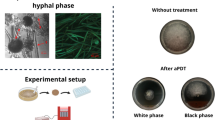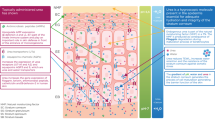Abstract
Indacrinone, a drug chemically related to ethacrynic acid, usually stimulated reversibly short circuit current and sodium influx when applied to the epithelial surface of amphibian skin. Concomitantly, transepithelial conductance,g t, decreased, provided chloride was the main anion in the incubation fluid.
Electrophysiological analysis including microelectrode impalement indicated that the drug increased the sodium-conductance at the apical border of the impaled (most likely granular) cells. The decrease ing t thus points at shunt conductance being reduced with indacrinone, sometimes drastically.
Decrease of transepithelial chloride flux with the drug as well as lack of effect of the drug ong t in the absence of chloride on the epithelial side demonstrate the influence of indacrinone on a chloride specific pathway. Whether this is along a paracellular route or through a cellular compartment not coupled to granular cells (mitochondria-rich cells?) cannot be decided on the basis of the present data.
Similar content being viewed by others
References
Beauwens R, Beaujean V, Crabbé J (1982) The significance of changes in thermodynamic affinity induced by aldosterone in sodium-transporting epithelia. J Membrane Biol 68:11–18
Beauwens R, Cragoe EJ Jr, Nagel W, Crabbé (1983) Unexpected effects of the action of indacrinone on amphibian epithelia. Arch Int Physiol Biochem 91:P113
Benos DJ (1982) Amiloride: a molecular probe of sodium transport in tissues and cells. Am J Physiol 242:C131-C145
Biber TUL, Walker TC, Mullen TL (1980) Influence of extracellular Cl concentration on Cl transport across isolated skin ofRana pipiens. J Membrane Biol 56:81–92
Brooks BA, Blair EM, Finch R, Lant AF (1980) Studies on the mechanism and characteristics of action of a uricosuric diuretic, indacrinone (MK-196). Brit J Pharmacol 10:249–258
Candia OA (1978) Reduction of chloride fluxes by amiloride across the short-circuited frog skin. Am J Physiol 234:F437-F445
Corcia A, Caplan SR (1982) Effect of furosemide on the electrical parameters of frog skin. Am J Physiol 243:F581-F587
Cuthbert AW, Edwardson JM, Aceves J, Wilson SA (1979) Amiloride as a membrane probe. In: Cuthbert A, Fanelli GM, Scriabine A (eds) Amiloride and epithelial sodium transport. Urban and Schwarzenberg, Baltimore, pp 113–123
Drewnowska K, Biber TUL (1983) Effect of changes in extracellular Cl activity on intracellular Cl activity and potential in isolated frog skin. J Gen Physiol 82:22a
Ehrenfeld J, Masoni A, Garcia-Romeu F (1976) Mitochondriarich cells of frog skin in transport mechanisms: morphological and kinetic studies on transepithelial excretion of methylene blue. Am J Physiol 231:120–126
Eigler J, Carl H, Edel HH (1966) Zum Wirkungsmechanismus der Etacrynsäure. I. Mitteilung. Der Einfluß von Etacrynsäure und Furosemid auf Membranpotential und Kurzschlußstrom an der Krötenhaut. Klin Wochenschr 44:417–424
Fanelli GM Jr, Bohn DL, Scriabine A, Beyer KH Jr (1977) Saluretic and uricosuric effects of (6,7-dichloro-2-methyl-1-oxo-2-phenyl-5-indanyloxy) acetic acid (MK-196) in the chimpanzee. J Pharmacol Exp Ther 200:402–412
Fanelli GM Jr, Smith IJ (1979) Dose-response relationships of (6,7-dichloro-2-methyl-1-oxo-2-phenyl-5-indanyloxy)acetic acid (MK-196) and isomers on Na-transport of isolated frogskin. Kidney Int 16:812
Ferreira KTG, Hill BS (1978) Chloride dependence of active sodium transport in frog skin: the role of intercellular spaces. J Physiol 283:283–305
Finn AL, Bright J (1978) The paracellular pathway in toad urinary blaadder: Permselectivity and kinetics of opening. J Membrane Biol 44:67–83
Fisher RS, Fanelli GM Jr, Helman SI (1977) Effect of (6,7-dichloro-2-methyl-1-oxo-2-phenyl-5-indanyloxy)acetic acid (MK-196) on Na transport of isolated frog skin. Kidney Int 14:758A
Fülgraff G, Gulden WD, Rudroff WD (1973) Effect of furosemide on sodium transport in frog skin. Interaction with amiloride and ouabain. Arch exp Path Pharmacol 280:23–28
Geck P, Pietrzyk C, Burckhardt BC, Pfeiffer B, Heinz E (1980) Electrically silent cotransport of Na, K and Cl in Ehrlich cells. Biochim Biophys Acta 600:432–447
Giraldez F, Ferreira KTG (1984) Intracellular chloride activity and membrane potential in stripped frog skin. Biochim Biophys Acta 769:625–628
Herms W, Hofmann KE (1965) Untersuchungen an der Froschhaut zur Kenntnis des Wirkungsmechanismus von Diuretika an transportaktiven Membranen. Arch Exp Path Pharmakol 251:355–374
Herrera FC, Esteve M (1977) Paradoxical stimulation of sodium transport in toad skin by ethacrynic acid. Gen Pharmacol 8:189–196
Kauker ML (1977) Clearance and micropuncture studies of the effects of a new indanyloxyacetic acid diuretic on segmental nephron functions in rats. J Pharmacol Exp Ther 200:81–87
Kristensen P (1981) Is chloride transfer in frog skin localized to a special type? Acta Physiol Scand 113:123–124
Kristensen P (1981) Exchange diffusion, electrodiffusion and rectification in the chloride transport pathway of frog skin. J Membrane Biol 72:141–151
Larsen EH, Kristensen P (1978) Properties of a conductive cellular chloride pathway in the skin of the toad (Bufo bufo). Acta Physiol Scand 102:1–21
Lote CJ (1976) Chloride transport in isolated frog (R. temp.) skin. Changes in short-circuit, potential, resistance and chloride flux elicited by furosemide. Pflügers Arch 362:181–184
MacKnight ADC (1977) Contribution of mucosal chloride to chloride in toad bladder epithelial cells. J Membrane Biol 36:55–63
Mandel LJ, Curran PF (1972) Chloride flux via a shunt pathway in frog skin: apparent exchange diffusion. Biochim Biophys Acta 282:258–264
Nagel W (1978) Effects of ADH upon electrical potential and resistance of apical and basolateral membranes of frog skin. J Membrane Biol 42:99–122
Nagel W, Bevenino-Macedo LH, Crabbé J (1982) Effect of indanone (MK-196) on active and passive transport parameters in frog and toad skin. Pflügers Arch 392:R18
Nagel W, Crabbé J (1980) Mechanism of action of aldosterone on active sodium transport across toad skin. Pflügers Arch 385:181–187
Nagel W, Garcia-Diaz JF, Essig A (1983) Contribution of junctional conductance to the cellular voltage-divider ratio in frog skins. Pflügers Arch 399:336–341
Nagel W, Karger W, (1964) Die Wirkung von 4-Chloro-N-(2-furylmethyl)-5-sulfamoylanthranil-säure (Lasix) auf ionenaktive Membranen. Pflügers Arch 281:R63–64
Nagel W, Wober W (1977) Effect of diazoxide on transport of Na+ and Cl− in the isolated frog skin and interactions of diazoxide with α- and β-blocking substances and phosphodiesterase inhibitors. In: Diuretics in research and clinics (Int. Symposium Bürgenstock). Georg Thieme, Stuttgart, pp 64–70
Natochin YV (1975) Hyperpolarization of the frog skin by furosemide. Bull Exper Biol 6:69–71
Ravenscroft PJ, Hall GR, Ahokas JT, Emmerson BT (1980) Indacrinone: modification of diuretic, uricosuric and kaliuretic actions by amiloride. Clin Pharmacol Ther 28:45–51
Rick R, Dörge A, v Arnim E, Thurau K (1978) Electron microprobe analysis of frog skin epithelium: Evidence for a syncytial sodium transport compartment. J Membrane Biol 39:313–331
Saito T, Lief PLD, Essig A (1974) Conductance of active and passive pathways in the toad bladder. Am J Physiol 226:1265–1271
Schlatter E, Greger R, Weidtke C (1983) Effect of “high ceiling” diuretics on active salt transport in the cortical thick ascending limb of Henle's loop of rabbit kidney: correlation of chemical structure and inhibitory potency. Pflügers Arch 396:210–217
Schnieders JR, Ludens JH (1980) Comparison of effects of standard diuretics and indanone in isolated toad cornea and bladder. Am J Physiol 238:R70-R75
Schoen HF, Grenn W, Erlij D (1980) Chloride moves across the frog skin through a conductive paracellular pathway. Physiologist 23:63
Solms SJ De, Woltersdorf OW Jr, Cragoe EJ Jr, Watson LS, Fanelli GM Jr (1978) (Acylaryloxy)acetic acid diuretics. 2. (2-Alkyl-2-aryl-1-oxo-5-indanyloxy)acetic acids. J Med Chem 21:437–443
Stoner LC, Trimble ME (1982) Effects of MK-196 and furosemide on in vitro rat medullary thick ascending limb of Henle's loop. J Pharm Exp Ther 221:715–720
Ussing HH (1982) Pathways for transport in epithelia. In: Corradino RA (ed) Functional regulation at the cellular and molecular levels. Elsevier, North Holland, pp 285–297
Ussing HH (1982) Volume regulation of frog skin epithelium. Acta Physiol Scand 114:363–369
Ussing HH, Zerahn K (1951) Active transport of sodium as a source of electric current in the short-circuited isolated frog skin. Acta Physiol Scand 23:110–127
Voute CL (1963) An electron micrografic study of the skin of the frog (Rana pipiens). J Ultrastruct Res 9:497–510
Voute CL, Meier W (1978) The mitochondria-rich cell of frog skin as hormone-sensitive “shunt-path”. J Membrane Biol 40 (special issue): 151–165
Wade JB (1978) Membrane structural specialization of the toad urinary bladder revealed by the freeze fraction technique. III. Location, structure and vasopressin dependence of intramembrane particle arrays. J Membrane Biol 40 (special issue): 281–296
Author information
Authors and Affiliations
Rights and permissions
About this article
Cite this article
Nagel, W., Beauwens, R. & Crabbé, J. Opposite effects of indacrinone (MK-196) on sodium and chloride conductance of amphibian skin. Pflugers Arch. 403, 337–343 (1985). https://doi.org/10.1007/BF00589243
Received:
Accepted:
Issue Date:
DOI: https://doi.org/10.1007/BF00589243




